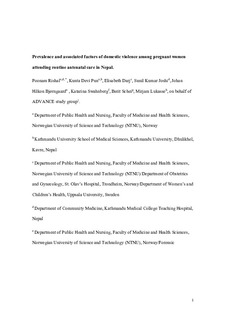Prevalence and associated factors of domestic violence among pregnant women attending routine antenatal care in Nepal
Rishal, Poonam; Pun, Kunta Devi; Darj, Elisabeth; Joshi, Sunil Kumar; Bjørngaard, Johan Håkon; Swahnberg, Katarina; Schei, Berit; Lukasse, Mirjam
Journal article
Submitted version
Permanent lenke
http://hdl.handle.net/11250/2490562Utgivelsesdato
2017Metadata
Vis full innførselSamlinger
Sammendrag
Aims: The primary aim of this study was to assess the prevalence of domestic violence (DV) and its associated factors among pregnant women in Nepal. The secondary aims were to investigate disclosure of DV by women to health-care personnel and to assess whether health-care personnel had asked women about their experience of DV. Methods: This cross-sectional study included 2004 pregnant women between 12 and 28 weeks of gestation attending routine antenatal care at two hospitals in Nepal from August 2014 to November 2015. In this study, DV was defined as fear of a family member and/or an experience of physical, emotional or sexual violence. Associated risk factors were analysed using logistic regression analyses. Results: Twenty-one per cent of the women had experienced DV; 12.5% experienced fear only, 3.6% violence only and 4.9% experienced both violence and fear. Less than 2% per cent reported physical violence during pregnancy. This study found that just 17.7% had ever been asked by health-care personnel about DV, and of the women who had reported DV, only 9.5% had disclosed their experience to health-care personnel. Women of young age and low socio-economic status were more likely to have experienced DV. Women who reported having their own income and the autonomy to use it were at significantly lower risk of DV compared to women with no income. Conclusions: A substantial proportion of women reported having experienced DV. Victims had rarely disclosed their experience of DV to health-care personnel. This study underlines the importance of integrating systematic assessment of DV in antenatal care.
